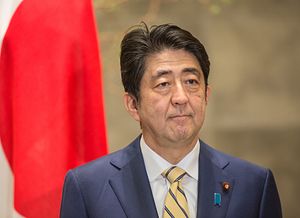Kasumigaseki vs Nagatacho – Japan’s powerful bureaucracy versus its political center. For the past three years, Prime Minister Shinzo Abe has decidedly tilted the balance in the latter direction.
After over half a century of almost unbroken LDP (Liberal Democratic Party) rule, the Democratic Party (DPJ) won a landslide victory in 2009 to rallying cries of breaking the bureaucracy’s power and handing it to elected representatives. They failed. The most severe challenge to Kasumigaseki, however, came not from the brief interlude of DPJ rule, but from the Abe government and the unprecedented strength of the prime minister. Four factors are chiefly responsible for this shift.
First, Abe’s stable premiership has halted (for now) the revolving door for Japan’s prime ministers, which was spinning since Koizumi left (there were five PMs between 2006 and 2012 alone). Tomomi Inada, a key figure in the LDP and herself seen as a future candidate for the top post, has recently suggested that Abe might still be in power in 2019 – this matters, since the most likely challenge to Abe’s rule will come from within the ruling party, rather than the lackluster opposition.
By extension, this is not only true of the prime minister, but also for other key personnel: this July, Yoshihide Suga will become the longest serving Chief Cabinet Secretary. This helps him in his role, which is to coordinate and keep in line the various ministries. Cabinet positions also no longer shift every other year, as has long been the case. The long tenures of Labor Minister Yasuhisa Shiozaki or Finance Minister Taro Aso are a case in point. Bureaucrats can no longer just sit back and hope that politicians they dislike will be gone in a year, followed by the next leader with a new set of priorities they can appear to implement while to a large extent pursuing their own policy preferences.
Longer tenure is not the only means by which Nagatacho asserts its control over Kasumigaseki. In 2014, Abe installed a Personnel Affairs Bureau at the Cabinet. This office grants him control over more than 600 bureaucratic appointments, tripling the previous number. More importantly, he is making full use of it. Prior to this, ministries handled promotions mostly internally, with their political leadership only providing rubberstamp approval. No longer; far beyond a few high profile appointments, such as of Abe’s chum Ichiro Komatsu as head of the legal affairs bureau, or of staunch conservatives to the board of NHK (Japan’s public broadcaster), the administration is getting involved on a much more granular level. In private conversations, dozens of senior bureaucrats stressed the long shadow of the personnel bureau. For bureaucrats desiring to be promoted to senior positions, not carefully treading the government line has become career threatening.
The third factor is the increased number of political appointments to ministries’ upper echelons – and stronger government interference in parliamentary bodies overseeing them. As one director general in the agriculture ministry (MAFF) remarked, political oversight over ministries is nowadays much tighter than it was a decade ago: where once the only political representatives were the minister and his deputy, now there are usually between five to seven political appointees. This development began years ago, but Abe is making strategic use of staffing to bring the ministries to toe the line.
Hisao Harihara, for example, an internationalist and proponent of agricultural reform, against all odds (and despite much hatred for him from inside MAFF), became vice minister. His appointment was part of the administration’s strategy to diminish MAFF’s power to oppose their push for a successful Trans-Pacific Partnership negotiation. Similarly, for the first time, with Ken Saito, a former economy ministry (METI) official became head of the LDP’s powerful agricultural policy grouping (norin bukai), which is key in overseeing MAFF. In private, senior officials at the TPP headquarters concede that this has Suga’s fingerprints all over it and speaks to the strong involvement of Abe and Suga in all key personnel decisions. After all, appointments like these mean that the positions that once were meant to form the lynchpin of MAFF’s and farmers’ opposition to TPP now were much less of a threat to Suga’s coordinating mandate.
The fourth mechanism is the concentration of policymaking expertise in the prime minister’s office, the kantei. This development is not unprecedented, either, but the degree to which it is happening is. Abe has installed no less than five councils advising him on his growth strategy alone, plus a number of individual advisers for various other topics. This is shifting much of the core competence and lever of influence of Kasumigaseki – policy formulation and expertise – from the ministerial deliberative councils, where laws used to be drafted almost exclusively, to the kantei. Under Abe, rather than the famous adage of the rule of the “iron triangle” (LDP + big business + Kasumigaseki), a new iron triangle of kantei + big business + handpicked advisers is setting the policy direction (one should note, however, that the latter still includes several influencers from METI, which has guarded its influence well).
The first of these four factors could be gone as suddenly as it appeared. The other three, however, are more structural in nature and will outlive Abe’s tenure. The strengthening of the kantei (and of the Cabinet Secretariat*) has been a powerful longer term trend in Japanese politics. Pushed by Abe and Suga with unprecedented focus and determination it has now reached new heights.
Nagatacho 1: Kasumigaseki 0.
Markus Winter is editor-in-chief of the not-for-profit Japan politics and economics blog plotted//grundriss. He also is a lecturer at Hosei University.
*Corrected from “Chief Cabinet Secretariat.”

































